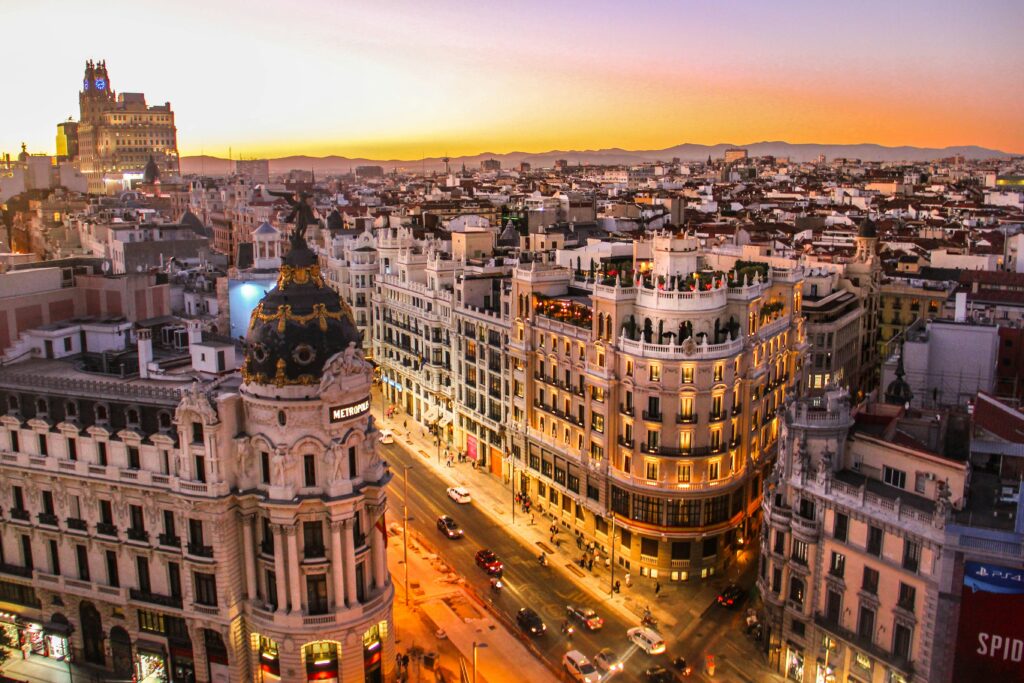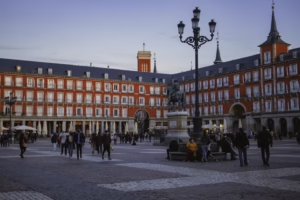Caption: Madrid, the second most attractive European city for investment
Source: Expansion
Introduction
Since 2024, Madrid has experienced a remarkable boom, and in 2025, it ranks among the top European destinations for real estate investment.
Thanks to its strategic location, economic dynamism, quality of life, and tax advantages, the Spanish capital is becoming a safe bet for investors, especially foreign ones.
The experts at Terreta Spain scan the city and explain everything to you.
A solid economy
Spain is experiencing its best moment
In contrast to France or Great Britain, where the economy is sluggish, Spain is enjoying a period of remarkable dynamism. The country is driving European growth with a GDP increase of 3.2% in 2024, exceeding forecasts (2.8%). In 2025, the IMF forecasts moderate but stable growth of around 2.1%, confirming the resilience of the Spanish economy despite the climate of global uncertainty since Donald Trump came to power.
The country's performance can be attributed to several factors:
- A thriving tourism sector, with nearly 95 million visitors in 2024, 10 million more than in 2023, and an increase of over 16% in their spending.
- Vigorous household consumption, supported by a continuously rising employment rate: the unemployment rate has fallen to stabilize at 10.6%, the lowest figure in 16 years.
- Rising exports according to the Spanish National Institute of Statistics: 2024 was the second-best year for exports in the country's recent history (+2.4% in one year).
- Spain is among the five countries in the world that attracted the most greenfield projects in 2024: nearly 700 projects, 33 billion euros of investment, and more than 60,000 jobs created (ICEX-Invest in Spain Barometer of the business climate in Spain).
Caption: Spain ends 2024 with an unemployment rate of 10.6%, the lowest rate in 16 years.
Source: 20 minutos
Madrid, the country's driving force
In 2024, the Community of Madrid recorded a 3.3% growth in its GDP, slightly exceeding the national average. This is the fourth consecutive year in which the region has surpassed the Spanish average! The capital is establishing itself as the country's economic engine and now accounts for 19.6% of the national GDP.
- The city is the leading job creator in the country: one in four companies created in Spain is created in Madrid.
- The Community of Madrid concentrates 43% of the country's technological professional profiles, according to the Official Website of the Community of Madrid.
- Madrid captures 72% of foreign investments in Spain, which is more than 17 billion euros (Madrid Investment Attraction).
All of this translates into a climate of confidence and a very positive international image. The Spanish capital has even recently surpassed Dubai and Paris in the ranking of preferred cities for the wealthy, according to the Barnes City Index.
Alvise Da Mosto, Associate Director Barnes Spain
A strategic geographical location and an exceptional quality of life
Another advantage is that Madrid enjoys an ideal location and excellent connectivity with the rest of the country and the world. It is very easy to get to Paris, London, or Berlin by plane for a business trip. Adolfo Suarez Madrid-Barajas Airport saw its number of travelers increase by 10% in 2024 compared to 2023 (66 million). It is the undisputed leader in Spain, including in terms of international traffic and freight transport.
The city's infrastructure is of remarkable quality. Madrid residents benefit from one of the best networks of transport, hospitals, schools (including international schools), and universities in the world.
The climate is pleasant, the pollution moderate, the cost of living reasonable, the purchasing power rather good... In short, Madrid is a great place to live, and its quality of life is beginning to be envied throughout the world. In 2024, Madrid is among the 10 best major cities to live in, according to Expat Insider.
Caption: The 10 best cities for expats.
Sources: Internations
A city undergoing profound transformation: modernization and ecology
Cutting-edge urban projects in 2025
In 2025, the Madrid City Council is investing hundreds of millions of euros in nearly 600 urban projects spread across all districts of the capital. These transformations undeniably reinforce the residential and heritage attractiveness of many neighborhoods, which offers excellent prospects for real estate appreciation in the medium term.
Among the emblematic operations, we can mention:
- The redevelopment of central squares: Dos de Mayo, Pedro Zerolo, Tirso de Molina, Jacinto Benavente, or the Sabatini Gardens.
- The enhancement of heritage: renovation of the Paseo del Prado, El Capricho Park, or the facade of the History Museum.
- The creation of new community facilities in Carabanchel, San Blas-Canillejas, and El Cañaveral, a growing neighborhood.
The Bosque Metropolitano: Madrid bets on green
Among the flagship projects of 2025 is the Bosque Metropolitano, a green belt of 75 km around Madrid, designed to create an ecological barrier against urban sprawl and increase the quality of life for local residents.
This project, several sections of which are already underway, concerns districts such as Villaverde, Usera, Vallecas, San Blas, and Hortaleza, where the prospects for real estate appreciation are real in the medium term.
Investing in these sectors in anticipation of landscape transformation could represent a strategic opportunity for buyers with reasonable budgets.
All of these massive investments demonstrate a clear commitment to modernizing Madrid in a sustainable, equitable, and attractive manner for investors.
A rapidly growing real estate sector
Madrid's real estate market is booming
Legend: The temperature of the Madrid market.
Source: Fotocasa
In a post-Covid context where investors typically favor safe markets like London and Paris, Madrid has achieved a remarkable feat. According to a PricewaterhouseCoopers study, it has risen from eighth to second place among the most attractive cities for real estate between 2020 and the end of 2024, relegating Paris to third place.
Caption: Madrid, the second most attractive European city for investment
Source: PWC
Nearly half of the properties purchased in the Community of Madrid were in the capital, with 7% of acquisitions made by foreigners. However, this figure is expected to increase in the coming years.
Real estate in Madrid: key figures
Legend: Evolution of purchase prices in Madrid since 2006
Source: Idealista
In Madrid, purchase prices have been steadily increasing since the end of the pandemic. In the spring of 2025, the average price reached €5,467/m², which is 24% higher than the previous year.
The price per square meter has soared in the capital's sought-after districts.
Focus on rentals
Here too, the trend is clearly upward. In one year, rents have increased by nearly 12% in the city, reaching €21.4/m2, which is €10 more than the national average.
Legend: Evolution of rental prices in Madrid since 2006
Source: Idealista
According to the latest data from Global Property Guide, Madrid is among the most attractive European capitals for rental investment, with an average gross yield of 4.82% in the first quarter of 2025 for apartments, and returns ranging from 2.76% to 6.63% depending on the district.
Peripheral districts and student residences in Madrid can offer peak yields exceeding 6%. This level of profitability places Madrid well ahead of cities like Paris or London, where rental yields generally fluctuate between 3% and 4% (Idealista).
This dynamic is due to strong rental demand, driven by students, young professionals, and expatriates, as well as the economic vitality of the region.
A dynamic and structured real estate market
Digital technology at the service of investors: Portal del Suelo 4.0
For several years, the Community of Madrid has offered a unique initiative: the Portal del Suelo 4.0, a free digital platform that lists all public plots available for purchase or concession in 47 municipalities of the region. This tool allows investors to access real-time information on available residential, industrial, or tertiary land, guaranteeing unprecedented transparency and legal security in Spain.
Legend: Suelo 4.0
Source: Official Website of the Comunidad de Madrid
Madrid commits to affordable housing with the Plan Vive
The Plan Vive, launched by the regional government, is a large-scale public-private project aimed at building 13,000 affordable rental homes by the end of the legislature. As of March 2025, 3,300 homes have already been delivered, 5,000 are under construction, and 4,500 will be specifically reserved for young people under 35.
This plan has already generated over 1 billion euros in investments and created 25,000 direct and indirect jobs. Further proof of the region's commitment to boosting the rental market while containing rent increases.
Advantageous taxation
Mbappé Law: thank you, football…
The Community of Madrid has recently approved a reduction in the regional share of IRPF (personal income tax) for new tax residents coming from abroad. The objective is clear: to attract talent and capital. The “Mbappé Law” came into effect in January 2024.
- It applies to individuals who have not been tax residents in Spain during the five preceding years and who establish their residence in the Community of Madrid.
- It offers a 20% deduction on Personal Income Tax for certain investments.
- Beneficiaries must maintain their investment and tax residence in the region for at least six years.
A regional tax policy further strengthened in 2025
Other tax measures support real estate investment:
- A tax reduction of €1,000 for owners renting out vacant housing for at least 3 years.
- A deduction for primary residence rental is extended to people aged 40.
- Aid compensating for the increase in interest rates for primary residences.
- Significant reductions on Property Transfer Tax for existing properties for large families, young people under 35, etc.
- A reduction in inheritance and gift taxes from 25% to 50% for certain heirs.
Future prospects
Madrid is resolutely forward-looking with ambitious projects, such as the “Madrid Nuevo Norte” project. It is the most ambitious urban transformation in Europe with 25 billion euros of committed public-private investments and is expected to generate more than 300,000 jobs.
In 2025, the first redevelopment works (roads, access) began, preparing for the launch of the first homes for 2027.
https://www.youtube.com/watch?v=xV8aoeRVUWA
Madrid is also banking on its citizens: 50 million euros of participatory investment
Madrid is not content with imposing projects from above: it relies on citizen participation to guide its development.
In 2025, Madrid residents were able to vote on the allocation of 50 million euros from the municipal budget through a process of participatory democracy. These projects, integrated into the 2026 and 2027 budgets, aim to improve local facilities in the neighborhoods. This creates a bond of trust with the residents and reinforces the long-term stability of residential areas — a new positive signal for investors seeking security and urban coherence.
Conclusion
Madrid's indisputable attractiveness now makes it a major hub for international real estate investment. Its ability to attract foreign capital in various sectors demonstrates its economic robustness and long-term potential. For investors looking for growth, stability, and attractive taxation in Europe, Madrid ticks all the boxes in 2025 — and probably beyond.
FAQ – Investing in Madrid in 2025
Why has Madrid become a major real estate investment hub?
Madrid attracts investors due to strong economic growth, favorable taxation, political stability, and a quality of life recognized worldwide.
Which real estate sectors are the most promising in Madrid in 2025?
Residential real estate in transforming neighborhoods, luxury real estate, offices, student housing, and co-living spaces.
What is the average rental yield in Madrid?
The average gross yield is 4.82% at the beginning of 2025, with peaks of up to 6.63% in peripheral districts and student residences.
Which major urban projects are enhancing Madrid's attractiveness?
Madrid Nuevo Norte (€25 billion, 300,000 jobs), the Bosque Metropolitano (75 km green belt), the Plan Vive (13,000 affordable homes), and more than 600 urban projects underway in 2025.
Can foreigners invest easily?
Yes. Madrid accounts for 72% of foreign investment in Spain. The city provides tools such as the Portal del Suelo 4.0, which facilitates access to public land for residential or industrial use.
What are the attractive tax measures in 2025?
The Mbappé Law allows a 20% deduction on the IRPF for new residents. Other measures include exemptions on transfers, deductions for long-term rentals, and reductions on inheritances and donations.
Which districts have experienced the highest price increases?
The Salamanca and Chamberí districts show increases of between 20 and 25% over one year, driven by their attractiveness and strong demand.
What are the growth prospects for the coming years?
Madrid is expected to continue to grow thanks to economic growth, solid rental demand, a favorable tax policy, and major urban projects underway.
Sources: Idealista, PWC, INE, Expansion, Fotocasa, Comunidad de Madrid







